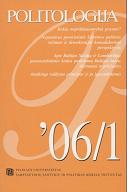Apie Baltijos Siciliją ir Lombardiją: Postsocialistinės kaitos pasiekimų Baltijos šalyse skirtumai ir priežastys
On Baltic Sicily and Lombardy: The Differences between Baltic Countries in the Achievements of Postsocialist Trasnformation and Their Causes
Author(s): Zenonas NorkusSubject(s): Politics / Political Sciences
Published by: Vilniaus universiteto leidykla & VU Tarptautinių santykių ir politikos mokslų institutas
Summary/Abstract: There are two important differences in the outcomes of postsocialist transformation of the Baltic countries: (1) Due to the inclusive citizenship laws the liberal democracy in Lithuania is more consolidated than in other Baltic countries. (2) However, in the economy Estonia has established reputation of “a shining star from the Baltics”, while Lithuania during first decade of market transition acquired the reputation of a pupil that although made the homework asked by the international institutions, but always a bit too late and never with excellent marks. While the explanation of the first difference is relatively uncontroversial, the opinions clash around the explanation of the differences in the economic performance. The article analyzes how can the reemergence of the difference between Baltic South and North be explained after the levels of socio-economic development between Baltic states had converged during the Soviet time? Did better initial economic conditions, peculiarities in the political process (e.g. exclusion of significant part of non-ethnical Estonian population that could be potential electorate for postcommunist party like the Lithuanian “Labourists”), Protestant cultural legacy, better public relation work – or what? – make Estonia “a shining star from the Baltics”? The paper closes with the discussion of the further difficulties of the culturalist explanation (including the Latvian riddle again) and possible solutions, and presents some proposals of further research relevant for the progress in the testing of conflicting explanations.
Journal: Politologija
- Issue Year: 2006
- Issue No: 1(41)
- Page Range: 71-119
- Page Count: 49
- Language: Lithuanian

